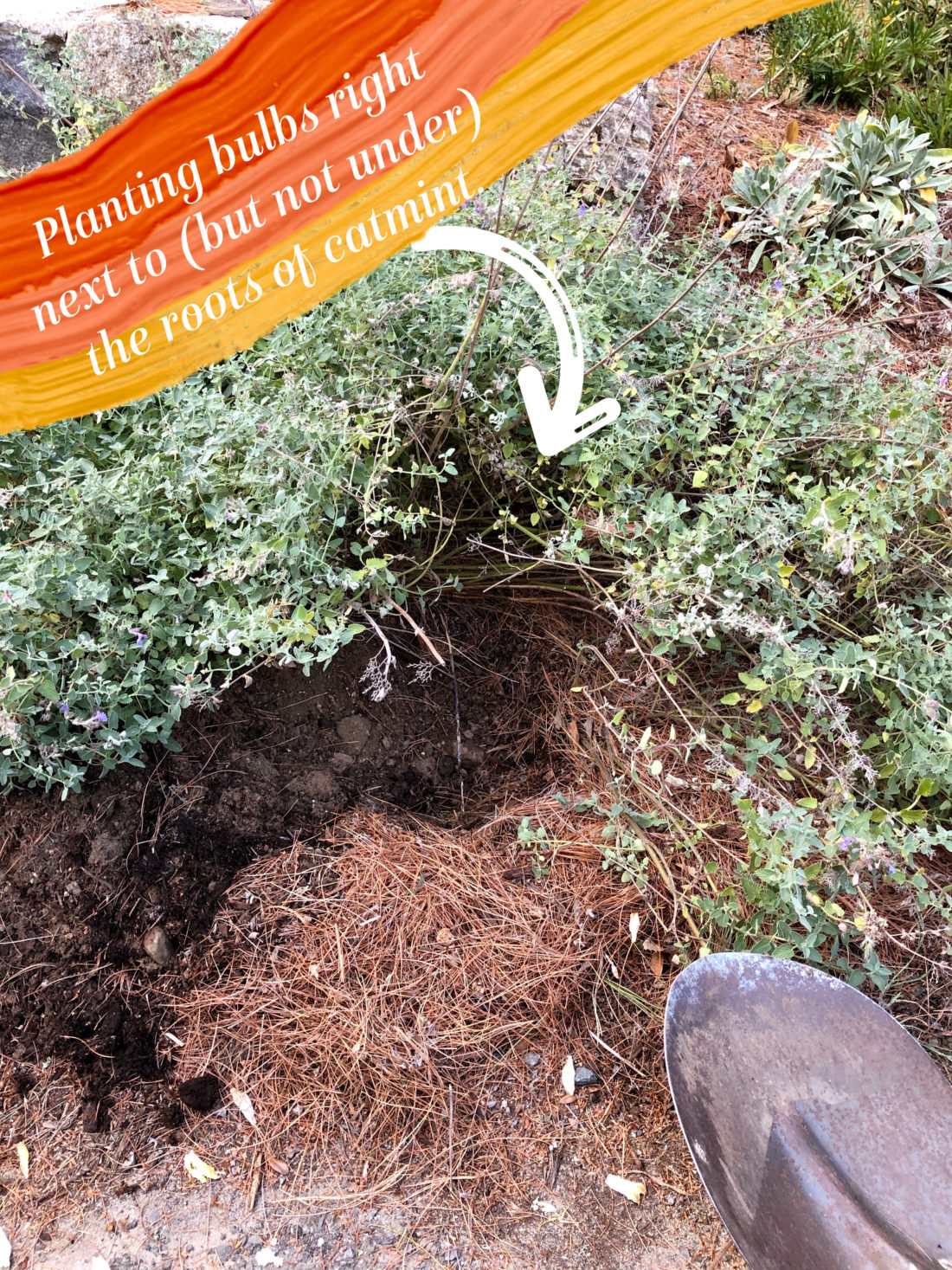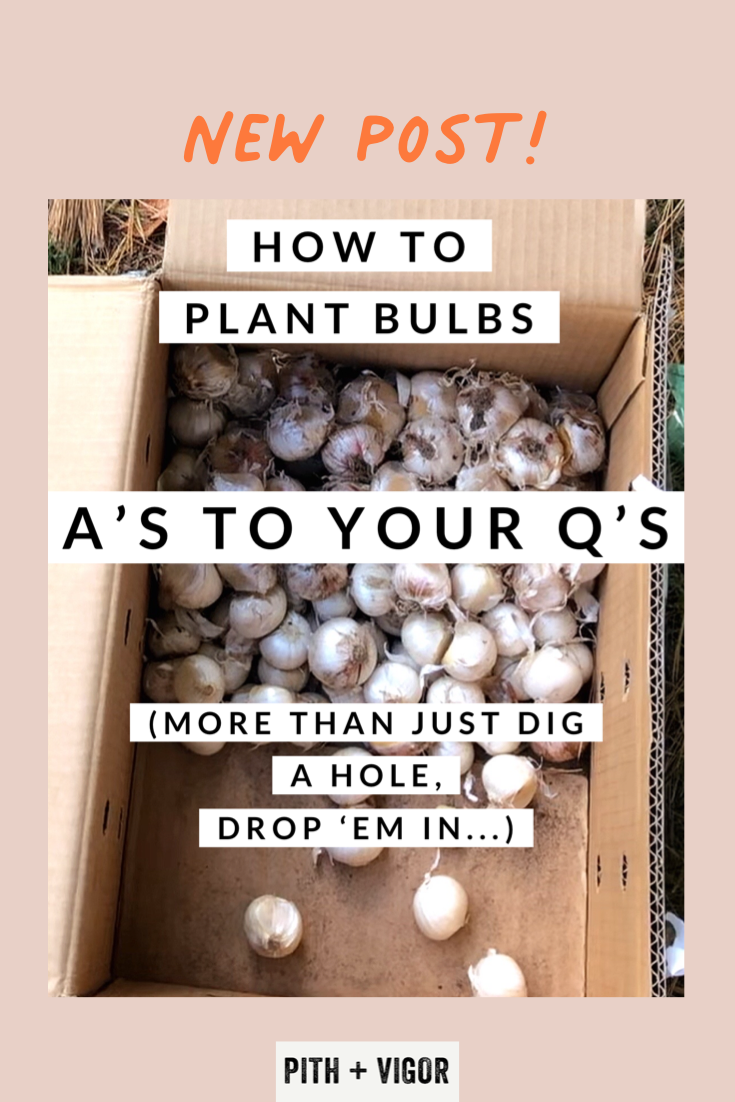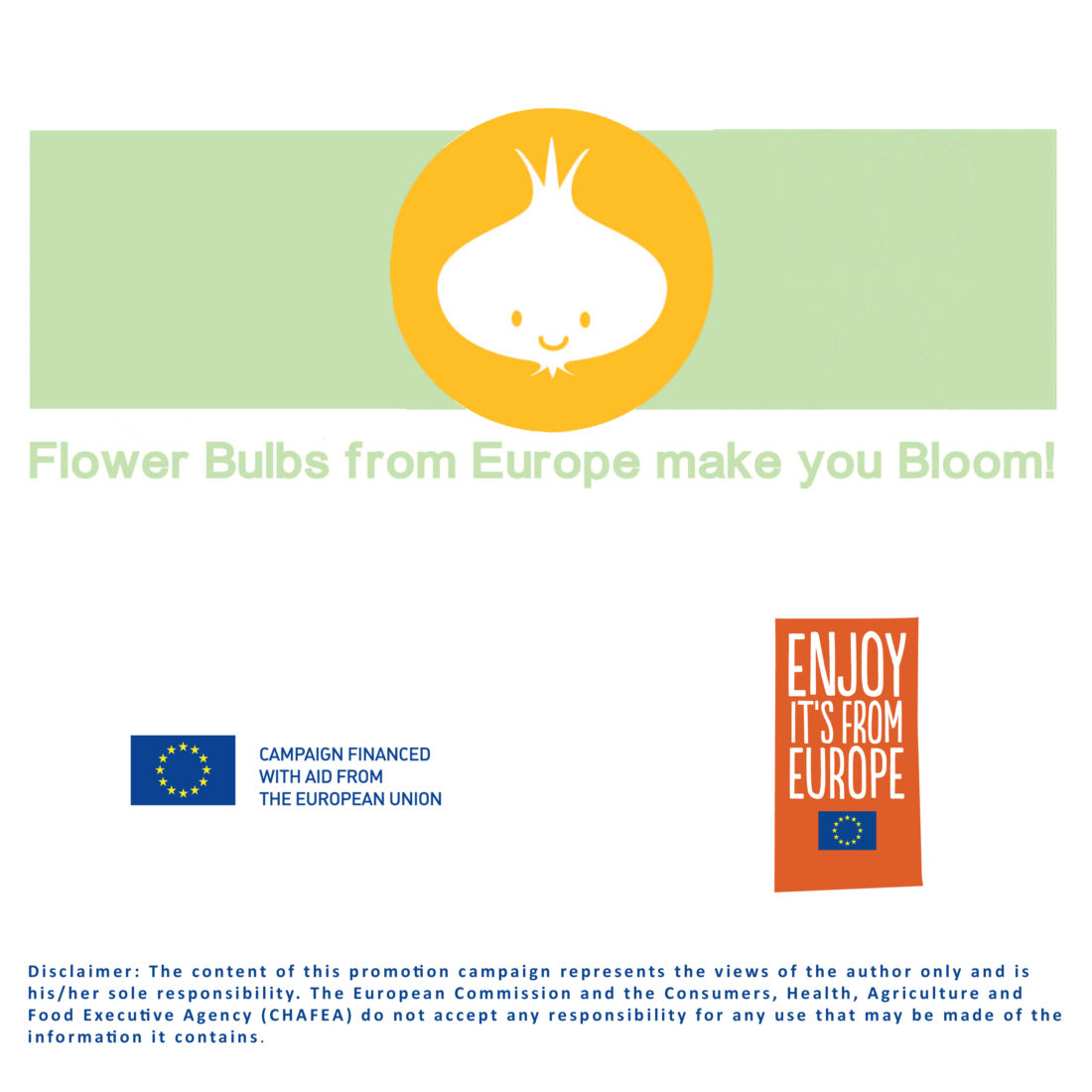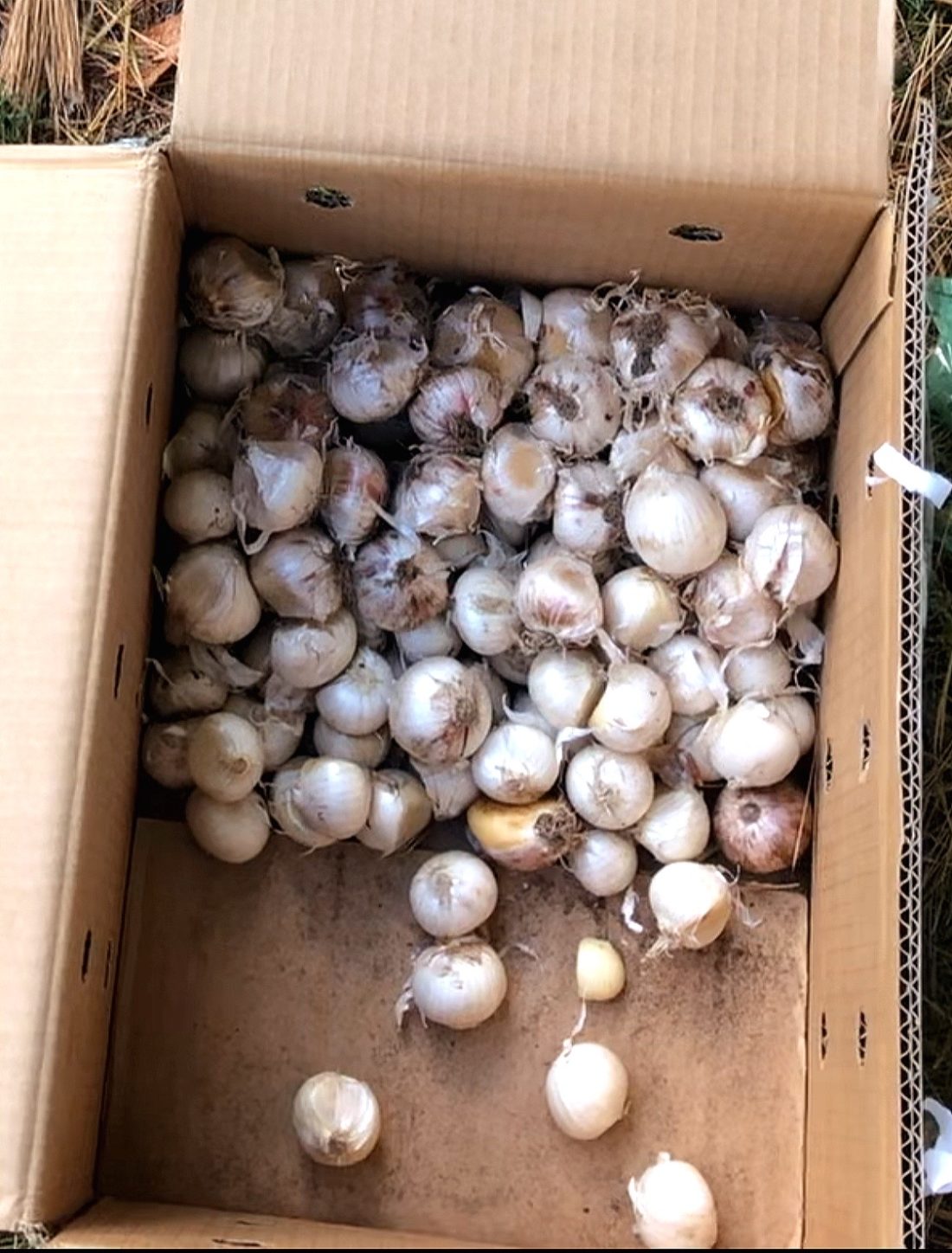Hey Guys!
As I’ve been planting lots of bulbs this year, many of you have been sending your bulb planting questions in DM’s and emails and asking in my garden design classes, and I’ve even had a couple of text messages (from those near and dear enough to have that #).
I thought I’d round them up for everyone since you are asking a bunch of things I would not have thought to tell you. (I love a good question… always better than me guessing what you want to know…so ask away!).
So here they are:
Are there different planting styles for bulbs?
Oh… this is such a GOOD question…It got me really thinking about styles (which I am always happy to do) and trying to put my finger on bulb-planting styles specifically.
And here is what I think: yes – there are styles – but I think you need to think of the options as a layer that fits on to the framework of whatever overall style you are trying to achieve in your garden. You’ll have other elements that give context to your bulb planting choices, but you can certainly use bulbs to make a statement.
Here is an example – if you are very avant-garde and modern with your planting – perhaps you might have a gorgeous lawn that you underplant with a sculptural snake of bulbs that erupt into an ephemeral and artistic design in the spring (you really have to see the cool example of this in my instagram stories here). I also think this could work for a garden that has a bohemian vibe or even just to be playful in a family garden.
Or maybe your garden is very naturalistic – If so, I’ll assume you have lots of flowing grasses that provide structure (and that can hide the dying foliage pretty easily). In that case, I think you might want to consider spreading clumps of bulbs out amongst the entirety of a bed area.
You could also consider drifts of colors just like you might with regular perennials. In this case, I’d focus not only on color but also on height so that you can achieve a layered look from your best vantage point.
(Tip: Always layout plants with an eye towards helping them look their best from the angles where they will most likely be viewed.)
There is also a more traditional way to plant bulbs and that is to line paths or other garden elements. In this case, I think it is always important to not be too rigid with your layout. Bulbs never look right when lined up like little perfect soldiers.
I always think they look best when planted at least a few to a hole, and depending on your preference and the type of flower and foliage, I think you can plant as many as 10 or 12 in a single clump. Let your holes make a little zig zag in your bed, it will feel nicer (IMO) than something that is super strict. Also – don’t be afraid to mix and match bulbs of different colors or type in one hole.
If you are doing this, it is good to have something else planted in that same area, and that serves a similar purpose later in the season. So, for example, a bed lined with bulbs in the spring can morph into a bed lined with daylilies in the summer. It keeps the style consistent, and the two plants can work together to not only extend the season but the incoming daylilies can mask the dying bulb foliage.
And then, of course, there are container-displayed bulb gardens, which are always inspiring but require a good number of pots and a place to set up the display.
Claus Dalby’s instagram is the best place to get the gist of this style. I’ve never done this myself, but it seems that sticking to a tight 2-3 color overall scheme helps; also, don’t overcomplicate it by planting more than one type of bulb in a pot. You can also plant bulbs in containers tighter than the recommended spacing on the packet. (I’ll explain why in a second – read on…)
I know there are other styles – block-like masses are one – but you almost never see that in a residential garden just because of the sheer volume it takes to completely fill even a small area with bulbs. But if you are thinking of doing this – perhaps in a more contemporary garden – I’d make it easier to get good coverage by digging the whole area out to the bulb planting depth (so you kind of have a shallow bathtub situation) and then place all the bulbs in at once and then cover with soil. This way, you can make sure to really get the even mass effect.
What am I missing? Can you think of a style of bulb planting that I didn’t mention?
Can you plant bulbs under perennials or other plants?
This is sort of a trick question, IMO.
The answer is technically yes… but when would you? Most of the perennials I plant are potted. I dig a hole and put the plant in. I might dig a wider hole and also put some bulbs in that hole- but it is unlikely that I would put them underneath the root ball of the perennial.
That just seems like pitting one plant against another plant in a little cage match where it is unclear if everyone might lose a little. I do, however, think that if you are planting plugs or from seed, it is very possible that you have bulbs in the perennial root ball – both plants will have grown around each other, and both will be fine.
That said – they actually might both be fine if you did that… it just seems like a weird thing to do. And I would never disrupt an established plant to lift it enough to slip some bulbs underneath when I could just as easily dig them in immediately adjacent to the same perennial and get almost the exact same effect.

But all that said, you might ask, But what about meadows? And you would be making a very good point… many meadows (including my own) are seed-planted and contain all sorts of perennials that are growing wherever the seed happened to land. And many meadows also have bulbs planted underneath (again, including my own). Are there perennials planted over the bulbs? – Yes, I am sure there are, and they are absolutely fine.
Can you layer bulbs? What are your tips?
Yes!! When I think of layering, I am generally thinking of layering things that are going to come up in different seasons. So for example – you can see a demo in this video:
I layered late-summer blooming allium (Allium sphaerocephalon) over spring-blooming tulips. These are easy to layer – the tulips are planted 2x as deep as the allium
Tip: How deep do you plant a blub? – Here is a quick rule of thumb on the bulb planting depth (without going back to check the package) Depth should simply be about 3x the height of the bulb. The tulips are big, but the particular allium (allium sphaerocephalon) that I was planting is comparatively small.
But maybe you want a succession of blooms among bulbs of the same size that bloom a little closer together (like early and mid-season daffodils, for example).
I’ll be honest – I am a lazy gardener, and I am blessed with space – so I would just put them together in a large container, mix them up and then plant them. The mixing in a box prevents me from getting tedious and precious about counting a certain number of each type of bulb into each of the holes… and ending up with something that is too exact.
I mix them together and let randomness take control – it is prettier and more natural-looking that way. But if you are tight for space, you might need to actually layer in your bulbs. In this case – the general guidance is to put the earlier blooming bulbs on top and then the later bloomers on lower layers.
When I am layering, I put in my lowest layer, then fill with dirt to at least the height of the top of the lower bulbs before putting my next layer in.
Do you need to follow the spacing guides and the depth guides?
No, and probably yes – a little. The depth guide (as I mentioned above) is typically based on the size of the bulb, and it is more than anything about getting the bulb deep enough not to be damaged by freezing temps. I wouldn’t mess with that one too much – but if you are layering, don’t worry if you fudge it all around by an inch or two inches.
Typically, I’d say go shallower – don’t go deeper. Deeper will risk the bulb having to put too much energy into getting out of the ground, and it may not bloom as well.
As for the spacing between bulbs – I am just going to come right out and say that I mostly ignore those guides. They are always wider than I want.
I like tight clumps of bulbs, and if you follow the spacing – they aren’t going to be that tight. It doesn’t hurt them to be closer – you do it in containers, after all. I think the only thing you might want to consider here is if you are hoping for a bulb to naturalize (some will, some won’t).
If it might naturalize – which is to say – it makes baby bulbs, and then you have more bulbs (and who doesn’t want that?) – then you need to let it have space to do that. Bulbs planted in containers aren’t expected to naturalize in that pot, so we don’t worry so much about space.
If they are naturalizing bulbs, you’ll want to take them out of the pot after they have bloomed and plant them in the ground. If it is something you are hoping will spread (this applies primarily to daffodils), then give them some space – but I’d say you can still err an inch or two closer than the smallest number in the recommended range.
How many bulbs do I need?
I really can’t answer this. It is always a multiple of how many square feet you have and how dense you want your plantings to be. But what I will say – you can never have too many. So whatever number you figure you need, you could literally double or triple it, and I’d bet money you’d not think it too many next spring.
It is near impossible to have too many, but plenty of people wish they had done more when spring comes around… so always go big.

When do you plant bulbs? What is the latest I can plant bulbs?
Spring flowering bulbs are planted now… in the fall. Summer and fall flowering bulbs are planted in the spring.
How late can you plant them?
In areas like New England, I would say anytime before the soil gets hard to work because it freezes. This usually happens in December – or sometimes even January… but don’t procrastinate because they also need between 12 and 16 weeks of cold in order to bloom properly.
So, doing the count backward math – Mid-March bulbs (the earliest around here) mean you better get them in at least a week or two before Christmas at the absolute latest. But is planting bulbs what you really want to be doing in December? I’m guessing not – shoot for October or November – and get that done now…
xo – Rochelle
More Bulb planting posts you might find helpful.

This post is sponsored by flowerbulbs.com

[…] This article was originally published by Pithandvigor.com. Read the original article here. […]
I’ve read that it helps if you just soak them in water for a day before planting them. Is this true?
Hi DIY Gardens – I don’t think you need to do that at all. In fact, I’d worry about overly waterlogging them. just get them into the ground while they are fresh and be done with it.